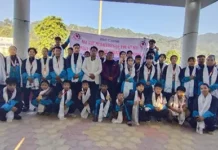[ Sachin Rana ]
Last week, news appeared in the leading dailies on the basis of the report of the Global Youth Tobacco Survey (GYTS)-2019 that Arunachal Pradesh and Mizoram have the highest tobacco consumption among school going children aged between 13 and 15 years at 57.9 percent, followed by three other northeastern states: Nagaland (42.6 percent), Meghalaya (33.6 percent) and Sikkim (24.8 percent). This issue anticipates greater attention of all the stakeholders of society.
In the GYTS-2019, almost 1 lakh children in the age group of 13-15 years were surveyed to provide information on tobacco use, cessation, second-hand smoke, access and availability, exposure to anti-tobacco information, awareness and receptivity to tobacco marketing, knowledge, and attitudes. In this detailed survey, our state has got the unwelcome tag of being home to the highest number of young smokers.
They say a cigarette contains 4,800 chemicals, 69 of which are cancer triggers. Now to elaborate the evils of smoking, the following data and inferences as available globally would be worthy to be reiterated. As per the World Health Organization (WHO), one out of seven deaths is related to smoking due to adverse effects on heart and lungs. Every year, around 8 million people die prematurely as a result of smoking. It can be said that tobacco kills more number of people in a day than terrorism kills in a year. As the pervasiveness of smoking is more among men, they account for three-quarters of the deaths from smoking. It has also been proven statistically that life expectancy of smokers reduces by at least 10 years.
Historically, as per the statistical data and records available globally, it can be stated that consumption of tobacco in the form of cigarettes and beedis was not much prevalent before the start of the 20th century. Thereafter, it became a norm and became the cult during the 1960s, and thereafter it is continuing but at a reduced pace. The reasons for such reductions are the research in the diagnosis of the cause of lung cancers and the policies of the government. However, there is still a lot to accomplish.
For us, Article 47 of the constitution of India is one of the directive principles which directs the state to raise the level of nutrition and the standard of living and to improve public health as among its primary duties and, in particular, the state shall endeavour to bring about prohibition of intoxicating drinks and drugs which are injurious to health. And then Article 246 has Schedule 7 for the state list of subjects, wherein Item No 6 (public health and sanitation, hospitals and dispensaries) has given the authority to the state government to maintain public health.
Logically, the actions taken so far by the union government can be enumerated here. India has adopted the tobacco control provisions under the WHO Framework Convention on Tobacco Control (WHOFCTC), wherein governments adopt and implement the tobacco control provisions of the WHOFCTC in their territories. Then, under the COTPA 2003, it has replaced the Cigarettes Act of 1975 and has included cigars, beedis, cheroots, pipe tobacco, hookah, chewing tobacco, pan masala and gutka under the act. Another milestone was the launch of the National Tobacco Control Programme (NTCP) in 2007-08, with the objectives to create awareness about the harmful effects of tobacco consumption, reduce the production and supply of tobacco products, ensure effective implementation of the anti-tobacco laws and help the people quit tobacco use through tobacco cessation centres, and with this the government has shown its unrelenting commitment to control the menace. Lately, by the promulgation of the Prohibition of Electronic Cigarettes Ordinance, 2019, we have prohibited production, manufacture, import, export, transport, sale, distribution, storage and advertisement of e-cigarettes. Now, the National Tobacco Quitline Services (NTQLS) with a toll-free number (1800-112-356) have the potential to reach a large number of tobacco users with the sole objective to provide telephone-based information, advice, support and referrals for tobacco cessation. The recently launched mCessation Programme is an initiative using mobile technology for tobacco cessation. It can be accessed using text messages as well.
Besides the above, notification of rules to ban smoking in public places, notification of rules to regulate depiction of tobacco products or their use in films and TV programmes, notification of rules on new pictorial health warnings on tobacco product packages and the launch of public awareness campaigns through a variety of media are simple yet effective measures to control the occurrence of smoking. Minimizing the ‘idol’ status attached with smoking onscreen has reduced the peer pressure among the youth and that’s why there is a 42 percent decline in tobacco use among 13-15-year-old school going children in the last decade, as per the GYTS-2019 report. This is surely some silver lining in this dense smoke.
State governments being primarily responsible for public health have added responsibility to execute the policies of the union government and the directions of the courts to reduce access among the young children to check smoking instances. Smoking in public places, direct/indirect advertisements of tobacco products, including sponsorship and promotion, sale of tobacco products to and by minors (less than 18 years of age) and sale of tobacco products within 100 yards of educational institutions are prohibited and are punishable offences. State government agencies must act on these regularly. Further, importantly, tobacco control cells as envisaged at the state and district level under the scheme of the NCTP must act proactively to control smoking among citizens.
In addition to the above, and as stated above, the menace can be controlled by active participation of all stakeholders. In this, the role of teachers is most crucial in creating awareness among children and their parents about the harm caused by tobacco use, and for shaping the attitude of children in this regard. The more and the sooner awareness is created among children about harms due to tobacco use, the better will be the outcomes in terms of reduction in prevalence of tobacco use among children and consequently among adults. Parents should also examine the activities of the children and motivate them to keep abeyance from such harmful practices. The society, through community-based organizations, student associations and community leaders, should be the torchbearer, so that smoke can be warded off by the light. After all, it is on us to thwart this, isn’t it? (The contributor is an IAS officer serving the Arunachal government. The views expressed are personal.)




